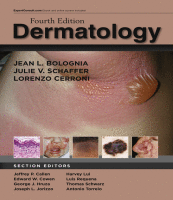Physical Address
304 North Cardinal St.
Dorchester Center, MA 02124

Introduction In this chapter, the major non-cicatricial (non-permanent) alopecias will be reviewed first, followed by a discussion of cicatricial alopecias and a review of structural hair shaft abnormalities. Chapter 68 reviews the structure and function of the hair follicle as…

Key features ▪ The pilosebaceous unit and nail apparatus are epidermal derivatives that produce two of the hardest epithelial structures in mammalian biology ▪ The hair follicle is the only continuously cycling organ in mammals, while the nail exhibits uninterrupted…

Skin color depends upon the amount and distribution of melanin and other pigments such as hemoglobin, which can influence light absorption, reflection, and scattering. Disorders of hyperpigmentation usually result from an increase in melanin production and, on occasion, from an…

Key features ▪ Leukoderma and hypopigmentation refer to lightening of the skin, which is classically due to decreased epidermal melanin (hypomelanosis) ▪ Melanocytopenic hypomelanosis, characterized by a reduction in the number of melanocytes, can result from a variety of defects…

Key features ▪ The major determinant of normal skin color is the activity of melanocytes, i.e. the quantity and quality of pigment production, not the density of melanocytes ▪ Melanocytes contain a unique intracytoplasmic organelle, the melanosome, which is the…

Key features ▪ The human neural tube is thought to close in an intermittent, multisite pattern, and neural tube defects that present as midline cutaneous lesions (e.g. cephaloceles, heterotopic brain tissue, rudimentary meningoceles) typically occur at the junction between two…

Introduction In this chapter, a number of genodermatoses are discussed that are not covered in other chapters of this textbook ( Table 63.1 ). Table 63.1 Genodermatoses. See also Chapter 55 . GENODERMATOSES Hereditary connective tissue disorders ( Chs 64…

Key features ▪ Mosaicism for genes expressed in the skin presents as a patchy distribution of affected and unaffected skin ▪ The classical pattern follows the lines of Blaschko but varies according to cell type and timing of mosaicism ▪…

Introduction Neurofibromatosis (NF) and tuberous sclerosis (TS) are neurocutaneous disorders, or phakomatoses. They are characterized by cutaneous lesions as well as peripheral and/or central nervous system neoplasms. Like most hereditary cancer syndromes, NF and TS are autosomal dominant in inheritance.…

Introduction Primary immunodeficiencies represent a heterogeneous group of inherited disorders characterized by immune system defects that result in susceptibility to infections as well as additional manifestations such as autoimmunity, allergy, and malignancy. The molecular bases have been defined for >200…